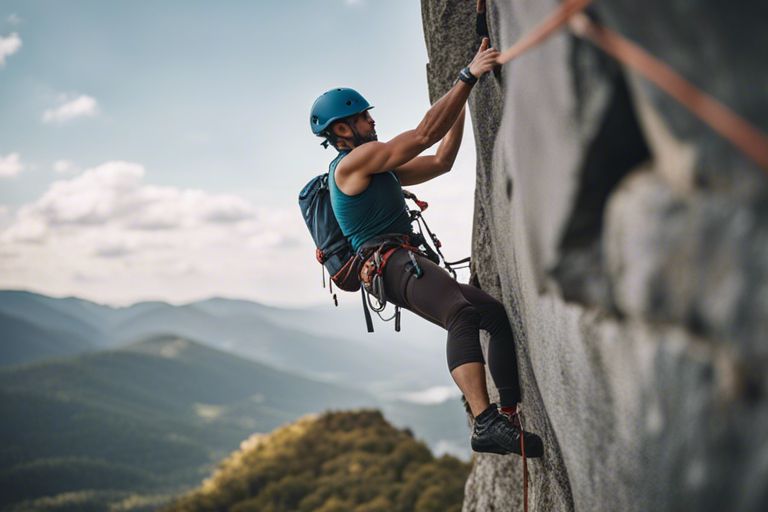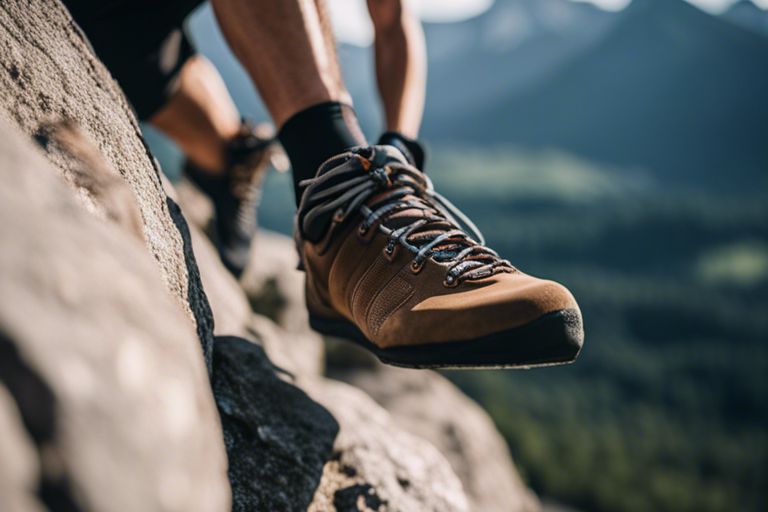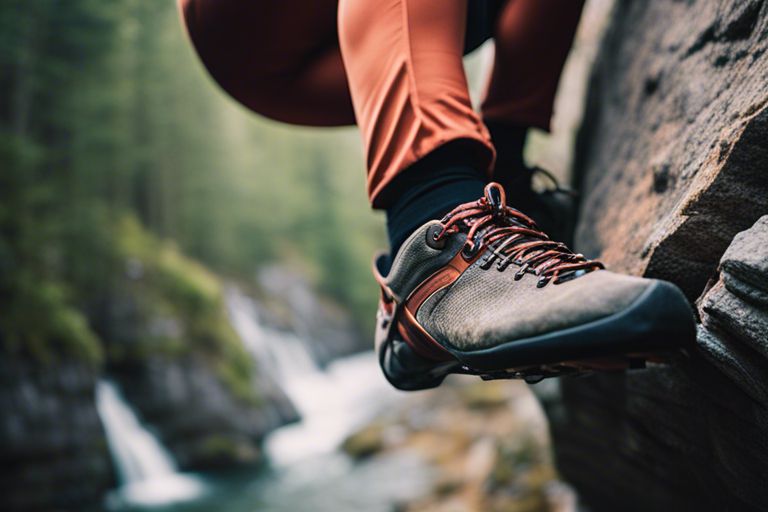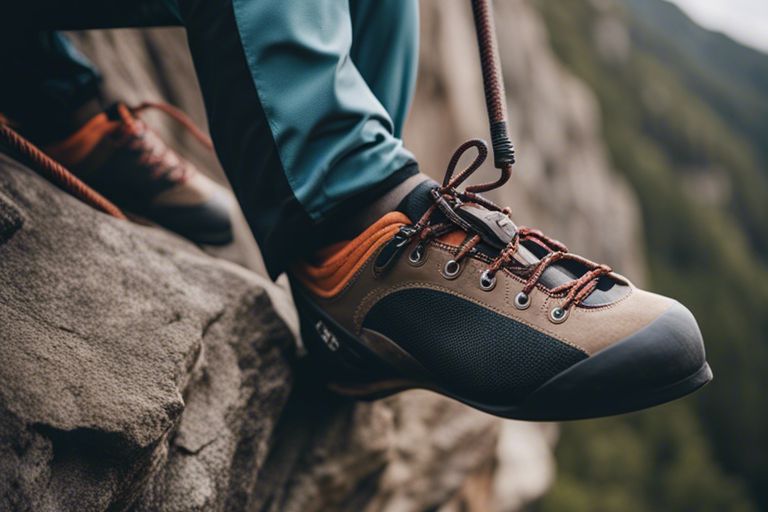Over the rugged terrains and daunting rock faces, your climbing shoes become your lifeline. The fit of your climbing shoes can significantly impact your performance and comfort on the cliff. In this guide, we probe into the nuanced art of finding the ideal tightness for your climbing shoes. So, as you venture into the vertical world, let’s unravel the mystery of just how tight your climbing shoes should be to optimize your climbing experience.
Key Takeaways:
- Comfort is key: Climbing shoes should fit snugly, but comfort should be prioritized. Shoes that are too tight can cause discomfort and hinder performance.
- Precision is important: A tighter fit can provide better precision and support while climbing. It helps with edging and smearing on small footholds.
- Personal preference matters: The ideal tightness of climbing shoes can vary from person to person. It is important to find a balance between snugness and comfort based on individual preferences and climbing style.
The Importance of Proper Fit
Preventing Discomfort and Pain
Importance of selecting climbing shoes that fit your feet properly cannot be overstated. Ill-fitting shoes can lead to a world of discomfort and pain while you climb. Shoes that are too loose can cause your feet to slide around, creating hot spots and blisters. Conversely, shoes that are too tight can squeeze your toes painfully, making it difficult to focus on your climb.
Improving Performance and Safety
Pain caused by improperly fitting climbing shoes not only hinders your performance but also jeopardizes your safety. When your feet are in agony, you are more likely to make mistakes and take unnecessary risks on the wall. Tight climbing shoes, while providing the necessary precision for difficult moves, should not sacrifice comfort for performance. It is vital to strike a balance between a snug fit and unbearable pain to maximize your climbing experience.
This balance between comfort and performance plays a crucial role in your climbing journey. As you progress in the sport, you will come to appreciate the subtleties of finding the right fit for your climbing shoes. Recall, a properly fitting shoe will enhance your climbing ability and keep you safe on the rock.
Factors Affecting Fit
Some key factors can affect how tight your climbing shoes should be. These factors include your foot shape and size, climbing style and technique, as well as the material and design of the shoe. Understanding these factors can help you find the perfect fit for your climbing adventures.
Foot Shape and Size
Shape plays a significant role in determining the right fit for your climbing shoes. Different brands and models cater to various foot shapes, such as narrow, wide, low volume, or high arches. It’s imperative to know your foot shape and size to choose a shoe that provides the right amount of snugness and support. Additionally, consider any specific foot issues or pain points that may affect how tight your shoes should be for comfort and performance.
Climbing Style and Technique
Technique and climbing style also impact how tight your shoes should be. If you prefer bouldering or sport climbing that require frequent toe hooks and precise foot placements, a tighter shoe might be more suitable to enhance sensitivity and control. On the other hand, for long multi-pitch routes or crack climbing where comfort and all-day wear are crucial, a slightly looser fit could be more appropriate. Understanding your climbing preferences and the types of routes you frequent can guide you in choosing the ideal shoe fit for your needs.
Design
Design material and shoe design are crucial factors when determining the tightness of your climbing shoes. Some shoes are designed with stretchy materials that conform to your foot over time, allowing for a more customized fit. Others are made with stiffer materials for durability and performance, which may require a tighter initial fit. Consider the closures and straps on the shoes as well, as they can affect the overall snugness and adjustability. Finding the right balance between material and design can help you achieve the perfect fit for your climbing pursuits.
Climbing
Climbing shoes are a imperative tool for any climber, and getting the right fit is crucial for both performance and comfort on the rock. By considering factors such as foot shape and size, climbing style and technique, as well as shoe material and design, you can find the perfect balance of snugness to enhance your climbing experience. Remember that the tightness of your shoes should ultimately support your climbing goals and preferences, so don’t be afraid to try on multiple pairs and test them out on different routes to find your ideal fit.
How to Determine the Right Tightness
Despite the wide range of climbing shoe designs and sizes available, finding the perfect fit can still be a challenge. However, there are a few key methods you can use to determine the right tightness for your climbing shoes.
The “Thumb Test”
On your first try of climbing shoes, use the “thumb test” to assess the fit. The idea is to make sure the shoe is snug but not painfully tight. Your toes should be curled slightly, but not cramped. Press down on the top of the shoe near your big toe – if you can fit the width of your thumb between your toes and the shoe, it’s a good indication of a proper fit.
The “Wiggle Room” Rule
Wiggle your toes in the shoe. They shouldn’t be able to move freely, but you should have just enough room to wiggle them slightly. Look for a secure fit that doesn’t allow your foot to slide within the shoe. Note, climbing shoes will stretch over time, so a snug fit initially is crucial.
Room for your toes to wiggle a bit will ensure blood circulation isn’t compromised during your climbs. This can help prevent discomfort and numbness, especially during longer climbing sessions.
Paying Attention to Pressure Points
Any uncomfortable pressure points in your climbing shoes can be a sign that they are too tight. Inspect your feet after climbing – if you notice redness, hot spots, or pain in specific areas, your shoes may be too snug. Adjusting the fit or trying a different size or model can help alleviate these pressure points.
It’s necessary to prioritize comfort while also aiming for a snug fit in your climbing shoes. Your performance and enjoyment on the rock greatly depend on finding the right balance of tightness and comfort.

Common Mistakes to Avoid
Shoes That Are Too Loose
For climbing shoes that are too loose, you will struggle to find the right balance and precision on the wall. Your feet will move around inside the shoe, causing discomfort and potential blisters. Additionally, loose shoes can affect your climbing performance as they won’t provide the necessary support for challenging moves.
Shoes That Are Too Tight
For climbing shoes that are too tight, you may experience intense pain and discomfort while climbing. This can distract you from focusing on your technique and enjoyment of the climb. Tight shoes can also lead to foot cramps and decreased blood circulation, making it harder to stay on the wall for extended periods.
The key is to find a snug but comfortable fit that provides the necessary support and precision without causing unnecessary pain or discomfort. It’s normal for climbing shoes to feel tight at first, but they should not be unbearable. Give your feet some time to adjust to the new shoes, but if the pain persists, it might be a sign that the shoes are too small.
Ignoring Break-In Periods
Commonly overlooked, ignoring the break-in period of climbing shoes can lead to discomfort and potential injury. Breaking in your shoes gradually allows them to mold to your feet, providing a better fit and increased comfort. Skipping this step can result in unnecessary pain, blisters, and decreased performance on the wall.
Ignoring the break-in period can also cause the shoes to wear out unevenly, reducing their lifespan. Take the time to gradually break in your climbing shoes by wearing them for short periods during climbing sessions or even around the house. This will allow the shoes to conform to your feet’s shape and ensure a more comfortable climbing experience in the long run.

Breaking In Your Climbing Shoes
Unlike other types of footwear, climbing shoes require a bit of breaking in to ensure a comfortable and precise fit for your climbing adventures. Here are some tips to help you break in your climbing shoes effectively.
Gradual Wear and Tear
One of the best ways to break in your climbing shoes is through gradual wear and tear. Start by wearing them for short periods during your climbing sessions and gradually increase the time as your shoes start to mold to your feet. This process allows the shoes to stretch and adapt to the shape of your feet, providing a better fit and improved performance on the rock.
Stretching and Conditioning Exercises
Your climbing shoes may feel tight initially, but don’t fret. There are stretching and conditioning exercises you can do to help accelerate the break-in process. These exercises not only help to soften the materials of the shoe but also aid in stretching out specific areas that may feel too snug.
Exercises: One effective exercise is to wear your climbing shoes at home while performing light stretches or walking around to help loosen them up. You can also use a shoe stretcher or wear them with thick socks to help expand the material.
Tips for Accelerating the Break-In Process
When breaking in your climbing shoes, there are a few tips that can help speed up the process:
- Try wearing your climbing shoes during shorter, less intense climbing sessions to gradually break them in.
- Utilize climbing shoe stretchers to help expand tight areas without compromising the overall shape of the shoe.
This will help ensure a comfortable fit without sacrificing performance on the wall.
Any climbing shoes will inevitably require some breaking in to achieve the perfect fit for your feet. By following these tips and being patient with the process, you’ll soon have a pair of climbing shoes that feel like a second skin and enhance your climbing experience.
- Note, it’s normal for climbing shoes to feel tight at first – they are designed to provide a snug fit for better precision and performance.
Tips for breaking in your climbing shoes may vary depending on the type and brand of shoe, so be sure to check for specific recommendations from the manufacturer. With time and use, your climbing shoes will mold to your feet, providing a custom fit that will elevate your climbing game.

Adjusting Fit for Different Climbing Disciplines
All climbers know that the fit of your climbing shoes can greatly impact your performance and comfort on the wall. Concerning adjusting the fit for different climbing disciplines, it’s necessary to consider the specific requirements of each type of climbing.
Sport Climbing vs. Traditional Climbing
One factor to bear in mind when adjusting the fit of your climbing shoes for sport climbing versus traditional climbing is the duration of your climbs. For sport climbing, where routes are typically shorter and more physically demanding, a tighter, more aggressive fit may be preferred to provide better precision and power. In contrast, traditional climbing often involves longer, more moderate routes where a slightly looser fit could offer more comfort during extended periods on the rock.
Bouldering vs. Top-Rope Climbing
Climbing shoes for bouldering and top-rope climbing also have distinct fit considerations. Bouldering often requires aggressive, downturned shoes for precise foot placements on small holds. In comparison, top-rope climbing, where comfort and endurance are key, may benefit from a more neutral, slightly looser fit to prevent foot fatigue on longer routes.
Another necessary aspect to keep in mind when adjusting the fit of your climbing shoes is the type of terrain you’ll be climbing on. For bouldering, where short, powerful movements are typical, a snug fit that minimizes dead space inside the shoe can enhance your performance. On the other hand, top-rope climbing, which involves more sustained climbing, might call for a more relaxed fit to prioritize comfort during extended periods on the wall.
Ice Climbing and Mixed Climbing
Climbing shoes for ice climbing and mixed climbing demand a specialized fit due to the unique challenges these disciplines present. In these cold, technical environments, a tighter fit is crucial to maintain good sensitivity and control over your foot placements on icy terrain. Additionally, snug-fitting shoes can help keep your feet warmer by minimizing air circulation within the shoe.
With the varying demands of each climbing discipline, it’s important to understand how adjusting the fit of your climbing shoes can enhance your performance and comfort on different types of climbs. By carefully considering the specifics of each discipline, you can optimize your shoe fit to suit the requirements of the terrain and movements you’ll encounter, ultimately improving your overall climbing experience.
Summing up
Drawing together the information presented, remember that finding the right fit for your climbing shoes is necessary for both performance and your overall climbing experience. While a snug fit is necessary for precision and control, make sure your shoes are not painfully tight, causing discomfort or limiting blood circulation. Take the time to try on different sizes and styles to find what works best for you, keeping in mind that personal preference and climbing style play a significant role in determining how tight your climbing shoes should be.
Q: How tight should climbing shoes be for beginners?
A: Climbing shoes should fit snugly but not be painfully tight, especially for beginners. It is recommended to look for a pair that is comfortably snug, with minimal dead space inside the shoe. This will provide enough support and sensitivity for beginners without causing discomfort.
Q: Should climbing shoes be looser for longer climbs?
A: Yes, for longer climbs, it is advisable to have slightly looser climbing shoes compared to shorter, more intense climbs. Looser shoes can help prevent excessive pressure and discomfort during extended periods of climbing, allowing for better blood circulation and improved overall comfort for the climber.
Q: How can I determine the right tightness for climbing shoes?
A: The right tightness for climbing shoes varies depending on personal preference, climbing style, and foot shape. One common method to determine the right tightness is to have a snug fit with minimal dead space, ensuring that there is no pain or hot spots while climbing. It’s imperative to try on different sizes and styles to find the best fit that provides a balance between comfort and performance.




